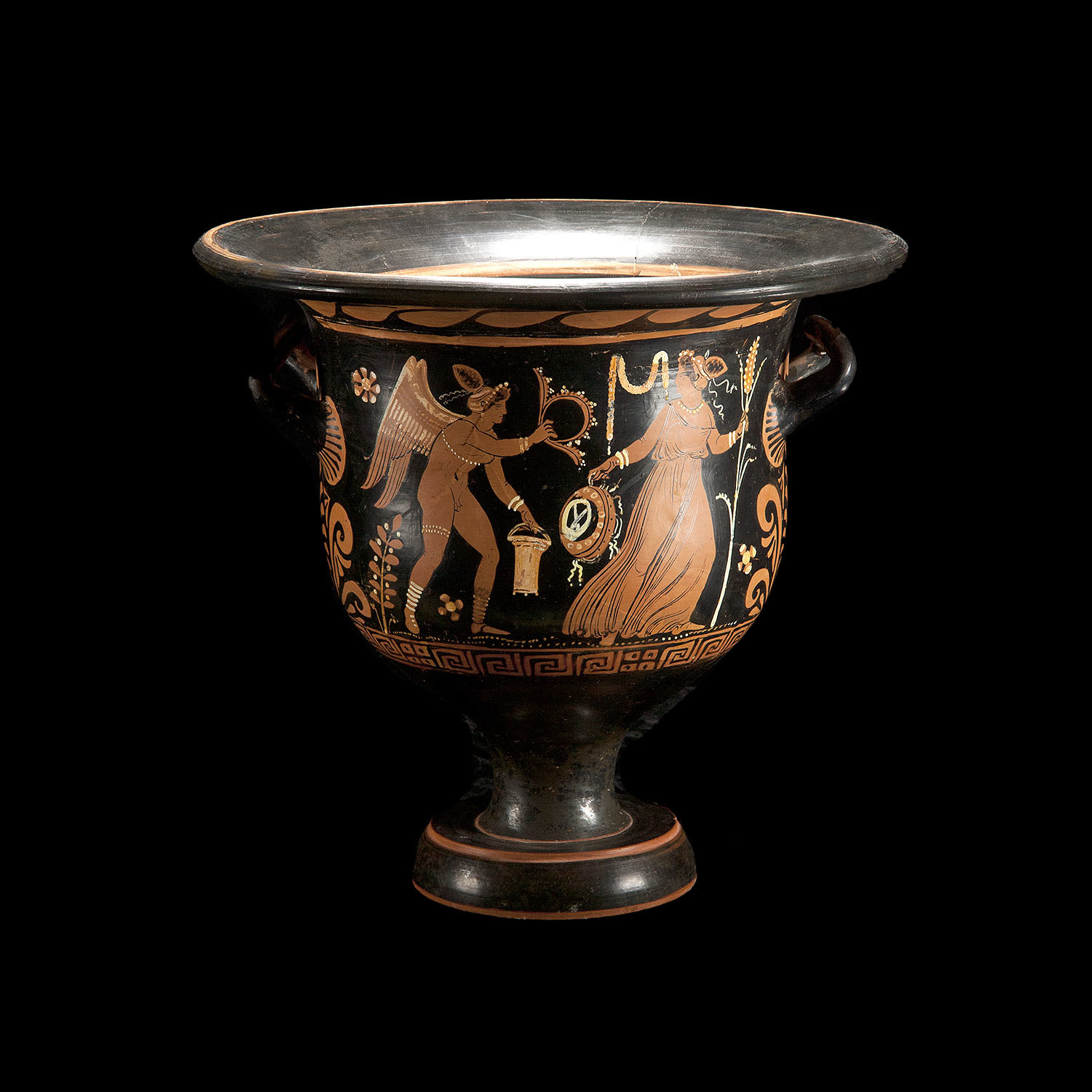- Feb 2, 2015
- 1,796
- 131
Seems to me the secular world knows more about this subject that Christians.
I post it as an FYI. I don't necessarily believe everything in this entry but the history is pretty much correct. If Israel never dealt with a fallen angel named "Ha Satan" then it's a good bet there never is a Satan as Christians believe today that he is a real personality.
I don't fear Satan for I know he/it is nothing but a story that developed as described below and entered our Christian language and culture over the centuries. Too bad there are not enlightened Christians who accept the Scripture as written and do not do their homework. So, For Your Information here's one entry taken from the source below.
FROM: The World History Encyclopedia
Satan, or the Devil, is one of the best-known characters in the Western traditions of Judaism, Christianity, and Islam. Surprisingly, this entity was a late comer in the ancient world. Satan, as a totally evil being, is nowhere to be found in the Jewish Bible. He evolved during the height of the Persian Achaemenid Empire (beginning c. 550 BCE) and was adopted by Jews living under Persian rule at the time. His formal name, Satan, derives from the Hebrew 'ha-Satan'. 'Ha' means 'the' and 'Satan' means 'opposer' or 'adversary'. The name described his eventual function as the opposer of God’s creation. Greek 'diabolos', English 'devil', meant 'accuser', 'slanderer', again describing his role. The concept of Satan emerged over time and in phases.
The Problem of the Existence of Evil
Evil has always existed. Humans encountered natural disasters (earthquakes, floods), wars with pillage and rape, disease, plagues, and infant mortality, man-made evil such as murders and theft, and of course, death. As the ancients constructed their religious systems, the existence of evil had to be explained and rationalized. Creation myths often designated a high god or a king of the gods, who controlled everything including the other gods as well as nature. In this capacity, they were responsible for both good and evil. The term to describe this ability is omnipotence (all-powerful).
In Deuteronomy 28, God declares that he controls both prosperity and suffering.
Many creation myths addressed how and why evil arose.
Genesis may be understood as a polemic against their neighbors, the ancient Mesopotamians. In the Mesopotamian creation myth, the Enuma Elish, the gods themselves are responsible for evil. They are capricious and chaotic and created humans simply as slaves to offer them sacrifices. The God of Israel is shown as the opposite; he is never capricious, there is a divine plan, and everything he created is deemed good. The narrative function of the 'fall' in the Garden of Eden, the story of Adam and Eve, was to demonstrate that evil began through the fault of humans, not God. Their disobedience led to man’s struggles to produce food and woman’s pain in childbirth. But the most severe punishment was the loss of their immortality. The sin of Adam and Eve brought on the greatest evil, death. As their descendants, we are all doomed to this fate.
Being human, people projected their own experiences upon the gods. Kings had courts of nobles and advisers. As on earth, so in the heavens. Like any court, there were higher and lower officials. The higher ones were the angels in Judaism. The lower deities, daemons (in Greek), were originally neutral but over time were blamed for evil.
In Genesis, God speaks to his court, "the sons of God", the angels, as he proceeds to create the earth. At the end of creation, we have a strange passage in Genesis 6. We read that "the sons of God" had intercourse with human women, producing the "Nephilim", ancient giants. The purpose of this narrative is to explain why God sent the flood (evil on the earth). Many pantheons had gods who mated with women, particularly Zeus in Greek mythology. Israelite tradition, however, rejected this behavior as this mixing could lead to the great sin of idolatry.
Ha-Satan & The Book of Job
The Book of Job (c. 600 BCE) is the earliest text to address the problem of theodicy, which is a modern term for the problem "If God is good, why does he permit evil and suffering to exist?" The book opens with the angels apparently reporting to God. Among them is the angel ha-Satan, whose function was to travel the world placing 'obstacles' (the meaning of his name) in front of humans, requiring them to make a choice (good or evil). In this role, we can say that he acts as God’s prosecuting attorney. Reporting back to God, he mentioned God’s servant Job, who had prospered. But, of course, he says, it is because God granted Job so much favor.
The bet is on. God tells ha-Satan to destroy all of Job’s prosperity, everything except his life. God is sure that Job will not turn away from him. Job’s children are killed, his crops and herds destroyed, and he suffers horrible diseases. Job’s friends all come to comfort him and convince him that he must have sinned because God is a god of justice. Throughout, Job insists that he never sinned; God has unfairly punished him. Frustrated, Job calls on God to explain, and a voice from the whirlwind admonishes him: "Where were you when I laid the earth's foundation?" (Job 38:4) In other words: 'How dare you (a mere mortal) question me?' Job is humbled and concedes the prerogatives and power of God.
Ha-Satan appears rarely in the Jewish scriptures. In the few references to ha-Satan, he opposes humans, not God. In Eden, the serpent serves this function, offering a choice to Adam and Eve. Throughout most of the books of the Prophets, evil is blamed on the people’s sin of idolatry. God is still in control punishing Israel.
Persian Rule & Zoroastrianism
When Jerusalem was conquered and destroyed by the Neo-Babylonian Empire (587 BCE), some Jews were taken into captivity in Babylon. Cyrus the Great then conquered the Babylonians in 550 BCE and established the Persian Empire. The state cult of Persia was Zoroastrianism, founded by the prophet Zoroaster. Evil was seen as the polar opposite of good. A pure, good being, Ahura Mazda ('Wise Lord') was the source of everything, and at the polar end was druj, chaos. Druj became personified as Angra Mainyu ('false', 'deception'), also known as Ahriman. The heavens, the earth, and all humans fall within this polar range.
Cyrus permitted the Jews to return to Jerusalem (539 BCE), although some stayed. They took many elements of ancient Persian religion with them, and they merged the personification of chaos with earlier views of ha-Satan. Now he was just Satan or, in Greek, diabolos, the Devil, and the Jews began assigning all evil to Satan instead of God.
The New Testament
Paul often referred to the demons as the agents of Satan who interfered with his mission. Writing from prison, Paul explained that he could not visit his community "because Satan hindered us" (1 Thessalonians 2:17-18). Paul’s inner struggles were expressed in what can be understood as a form of possession: "And to keep me from being too elated ... a thorn was given me in the flesh, a messenger of Satan, to harass me ..." (2 Corinthians 12:7-9). Paul saw this as God’s ability to control Satan to test him. His familiar phrase, that believers now live in Christ, referred to Christ’s protection against the influence of Satan’s demons in the universe.
Characteristics of Satan & the Personification of Evil
Christian leaders in the 2nd century CE adopted the method of the personification of evil against Jews, women, heretics, and all things pagan. The native cults believed that the gods resided in their temples, but these were agents of Satan. The first iconic portraits of Satan came from the Greco-Roman fertility deity, Pan, who was half-man, half-goat. This is how Satan got his hooves and horns. Pan was represented with and was famous for a huge, erect phallus. This appendage became common in describing Satan. At first, drawn black, red became the standard color in his association with hellfire.
It was also in the 2nd century CE that both Christians and Jews - the early Rabbis - applied new understandings to the story of the fall. This is when the serpent became fully identified as the Devil in disguise and Eve took on more significance as the primary sinner in Eden. With misogynistic views of all women, Eve was understood to have been seduced by the serpent (because of that huge phallus), and then she seduced Adam. In the Rabbinic treatise, Genesis Rabbah, Eve’s sexual shame is why women remain veiled, and that menstruation was the punishment for shedding the blood of Adam. Tertullian, a 2nd-century CE Church Father, claimed that through Eve all women were the "Devil's gateway" and because of Eve "even the son of God had to die" (On the Apparel of Women, I).
The religious traditions of Europe (the Celts, Druidism, and Teutons) added other characteristics. The Celts had a horned god of the west, Cernunnos, similar to Pan. The daughter of Loki had a dual role in fertility as well as rule over the dead, and her name became incorporated to the place 'Hel' or Hell.
I post it as an FYI. I don't necessarily believe everything in this entry but the history is pretty much correct. If Israel never dealt with a fallen angel named "Ha Satan" then it's a good bet there never is a Satan as Christians believe today that he is a real personality.
I don't fear Satan for I know he/it is nothing but a story that developed as described below and entered our Christian language and culture over the centuries. Too bad there are not enlightened Christians who accept the Scripture as written and do not do their homework. So, For Your Information here's one entry taken from the source below.
FROM: The World History Encyclopedia
Satan, or the Devil, is one of the best-known characters in the Western traditions of Judaism, Christianity, and Islam. Surprisingly, this entity was a late comer in the ancient world. Satan, as a totally evil being, is nowhere to be found in the Jewish Bible. He evolved during the height of the Persian Achaemenid Empire (beginning c. 550 BCE) and was adopted by Jews living under Persian rule at the time. His formal name, Satan, derives from the Hebrew 'ha-Satan'. 'Ha' means 'the' and 'Satan' means 'opposer' or 'adversary'. The name described his eventual function as the opposer of God’s creation. Greek 'diabolos', English 'devil', meant 'accuser', 'slanderer', again describing his role. The concept of Satan emerged over time and in phases.
The Problem of the Existence of Evil
Evil has always existed. Humans encountered natural disasters (earthquakes, floods), wars with pillage and rape, disease, plagues, and infant mortality, man-made evil such as murders and theft, and of course, death. As the ancients constructed their religious systems, the existence of evil had to be explained and rationalized. Creation myths often designated a high god or a king of the gods, who controlled everything including the other gods as well as nature. In this capacity, they were responsible for both good and evil. The term to describe this ability is omnipotence (all-powerful).
In Deuteronomy 28, God declares that he controls both prosperity and suffering.
Many creation myths addressed how and why evil arose.
Genesis may be understood as a polemic against their neighbors, the ancient Mesopotamians. In the Mesopotamian creation myth, the Enuma Elish, the gods themselves are responsible for evil. They are capricious and chaotic and created humans simply as slaves to offer them sacrifices. The God of Israel is shown as the opposite; he is never capricious, there is a divine plan, and everything he created is deemed good. The narrative function of the 'fall' in the Garden of Eden, the story of Adam and Eve, was to demonstrate that evil began through the fault of humans, not God. Their disobedience led to man’s struggles to produce food and woman’s pain in childbirth. But the most severe punishment was the loss of their immortality. The sin of Adam and Eve brought on the greatest evil, death. As their descendants, we are all doomed to this fate.
Being human, people projected their own experiences upon the gods. Kings had courts of nobles and advisers. As on earth, so in the heavens. Like any court, there were higher and lower officials. The higher ones were the angels in Judaism. The lower deities, daemons (in Greek), were originally neutral but over time were blamed for evil.
In Genesis, God speaks to his court, "the sons of God", the angels, as he proceeds to create the earth. At the end of creation, we have a strange passage in Genesis 6. We read that "the sons of God" had intercourse with human women, producing the "Nephilim", ancient giants. The purpose of this narrative is to explain why God sent the flood (evil on the earth). Many pantheons had gods who mated with women, particularly Zeus in Greek mythology. Israelite tradition, however, rejected this behavior as this mixing could lead to the great sin of idolatry.
Ha-Satan & The Book of Job
The Book of Job (c. 600 BCE) is the earliest text to address the problem of theodicy, which is a modern term for the problem "If God is good, why does he permit evil and suffering to exist?" The book opens with the angels apparently reporting to God. Among them is the angel ha-Satan, whose function was to travel the world placing 'obstacles' (the meaning of his name) in front of humans, requiring them to make a choice (good or evil). In this role, we can say that he acts as God’s prosecuting attorney. Reporting back to God, he mentioned God’s servant Job, who had prospered. But, of course, he says, it is because God granted Job so much favor.
The bet is on. God tells ha-Satan to destroy all of Job’s prosperity, everything except his life. God is sure that Job will not turn away from him. Job’s children are killed, his crops and herds destroyed, and he suffers horrible diseases. Job’s friends all come to comfort him and convince him that he must have sinned because God is a god of justice. Throughout, Job insists that he never sinned; God has unfairly punished him. Frustrated, Job calls on God to explain, and a voice from the whirlwind admonishes him: "Where were you when I laid the earth's foundation?" (Job 38:4) In other words: 'How dare you (a mere mortal) question me?' Job is humbled and concedes the prerogatives and power of God.
Ha-Satan appears rarely in the Jewish scriptures. In the few references to ha-Satan, he opposes humans, not God. In Eden, the serpent serves this function, offering a choice to Adam and Eve. Throughout most of the books of the Prophets, evil is blamed on the people’s sin of idolatry. God is still in control punishing Israel.
Persian Rule & Zoroastrianism
When Jerusalem was conquered and destroyed by the Neo-Babylonian Empire (587 BCE), some Jews were taken into captivity in Babylon. Cyrus the Great then conquered the Babylonians in 550 BCE and established the Persian Empire. The state cult of Persia was Zoroastrianism, founded by the prophet Zoroaster. Evil was seen as the polar opposite of good. A pure, good being, Ahura Mazda ('Wise Lord') was the source of everything, and at the polar end was druj, chaos. Druj became personified as Angra Mainyu ('false', 'deception'), also known as Ahriman. The heavens, the earth, and all humans fall within this polar range.
Cyrus permitted the Jews to return to Jerusalem (539 BCE), although some stayed. They took many elements of ancient Persian religion with them, and they merged the personification of chaos with earlier views of ha-Satan. Now he was just Satan or, in Greek, diabolos, the Devil, and the Jews began assigning all evil to Satan instead of God.
The New Testament
Paul often referred to the demons as the agents of Satan who interfered with his mission. Writing from prison, Paul explained that he could not visit his community "because Satan hindered us" (1 Thessalonians 2:17-18). Paul’s inner struggles were expressed in what can be understood as a form of possession: "And to keep me from being too elated ... a thorn was given me in the flesh, a messenger of Satan, to harass me ..." (2 Corinthians 12:7-9). Paul saw this as God’s ability to control Satan to test him. His familiar phrase, that believers now live in Christ, referred to Christ’s protection against the influence of Satan’s demons in the universe.
Characteristics of Satan & the Personification of Evil
Christian leaders in the 2nd century CE adopted the method of the personification of evil against Jews, women, heretics, and all things pagan. The native cults believed that the gods resided in their temples, but these were agents of Satan. The first iconic portraits of Satan came from the Greco-Roman fertility deity, Pan, who was half-man, half-goat. This is how Satan got his hooves and horns. Pan was represented with and was famous for a huge, erect phallus. This appendage became common in describing Satan. At first, drawn black, red became the standard color in his association with hellfire.
It was also in the 2nd century CE that both Christians and Jews - the early Rabbis - applied new understandings to the story of the fall. This is when the serpent became fully identified as the Devil in disguise and Eve took on more significance as the primary sinner in Eden. With misogynistic views of all women, Eve was understood to have been seduced by the serpent (because of that huge phallus), and then she seduced Adam. In the Rabbinic treatise, Genesis Rabbah, Eve’s sexual shame is why women remain veiled, and that menstruation was the punishment for shedding the blood of Adam. Tertullian, a 2nd-century CE Church Father, claimed that through Eve all women were the "Devil's gateway" and because of Eve "even the son of God had to die" (On the Apparel of Women, I).
The religious traditions of Europe (the Celts, Druidism, and Teutons) added other characteristics. The Celts had a horned god of the west, Cernunnos, similar to Pan. The daughter of Loki had a dual role in fertility as well as rule over the dead, and her name became incorporated to the place 'Hel' or Hell.






